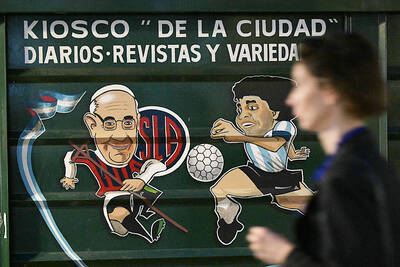When Japanese sumo wrestler Takuya Saito retired from the sport at 32 and began jobhunting, he had no professional experience and did not even know how to use a computer.
Athletes in many sports can struggle to reinvent themselves after retirement, but the challenge is particularly acute for those in the world of sumo.
Wrestlers are often recruited early, sometimes as young as 15, and their formal education ends when they move into the communal stables where they live and train.

Photo: AFP
That can leave them in for a rude awakening when their topknots are shorn in the ritual that marks their retirement.
When Saito left sumo, he considered becoming a baker, inspired by one of his favorite cartoons.
“However, when I tried it out, they told me I was too big” for the kitchen space, said the 40-year-old, who weighed in at 165kg during his career. “I had several job interviews, but I didn’t have any experience... They rejected me everywhere.”
Professional sumo wrestlers, or rikishi, who rise to the top of the sport can open their own stables, but that is not an option for most.
Last year, of 89 professional wrestlers who retired, just seven remained in the sumo world.
For the others, the restaurant industry sometimes appeals, offering a chance to use the experience gained cooking large meals for their stablemates.
Others become masseurs after years of dealing with aching muscles, or leverage their heft to become security guards.
However, trying to start over when non-sumo peers can be a decade or more into a career track is often demoralizing.
Saito said he developed an “inferiority complex” and found the experience of jobhunting far harsher than the tough discipline of his life as a rikishi.
“In sumo, the stable master was always there to protect us,” he said, adding that his former stable master offered him a place to stay, meals and clothes until he found his feet.
Many wrestlers leave the sport with little or no savings, because salaries are only paid to the 10 percent of rikishi in the sport’s two top divisions.
Lower-ranking wrestlers get nothing but room, board and tournament expenses.
Saito wanted to be his own boss, so became an administrative scrivener, a legal professional who can prepare official documents and provide legal advice.
The qualifying exam is notoriously tough and when Saito passed he opted to specialize in procedures related to restaurants, hoping to help other former wrestlers.
His first client was Tomohiko Yamaguchi, a friend in the restaurant industry with an amateur sumo background.
“The sumo world is very unique and I think that outsiders can’t understand it,” Yamaguchi told reporters, suggesting that society can sometimes prejudge rikishi.
Wrestlers who go from being stopped for photos and showered with gifts can also struggle with fading into obscurity. A rare few might end up with television gigs that keep them in the public eye, but for most, the limelight moves on.
Keisuke Kamikawa joined the sumo world at 15, “before even graduating high school, without any experience of adult life in the outside world,” he told reporters.
Today, the 44-year-old heads SumoPro, a talent agency for former wrestlers that helps with casting and other appearances, but also runs two day centers for elderly people, staffed in part by retired rikishi.
“It’s a completely different world from sumo, but rikishi are used to being considerate and caring” because lower-ranked wrestlers serve those in the upper echelons, Kamikawa said.
Shuji Nakaita, a former wrestler now working at one of Kamikawa’s care centers, spent years helping famed sumo champion Terunofuji.
“I prepared his meals, I scrubbed his back in the bath ... there are similarities with care of the elderly,” he said after a game of cards with two visitors to the center.
And while the sight of hulking former rikishi around diminutive elderly men and women might appear incongruous, the retired wrestlers are popular.
“They are very strong, very reassuring and gentle,” said Mitsutoshi Ito, a 70-year-old who says he enjoys the chance to chat about sumo with former wrestlers.
Kamikawa has also set up a group that provides advice on post-sumo careers to wrestlers and families worried that their sons are not planning for their future.
“Sumo is a world where you have to be ready to put your life in danger to win a fight,” said Hideo Ito, an acupuncturist who has worked with rikishi for more than two decades. “For these wrestlers who are giving it their all, thinking about the future can seem like a weakness in their armor.”

If the Wild finally break through and win their first playoff series in a decade, Minnesota’s top line likely will be the reason. They were all over the Golden Knights through the first two games of their NHL Western Conference quarter-finals series, which was 1-1 going back to Minnesota for Game 3 today. The Wild tied the series with a 5-2 win on Tuesday. Matt Boldy had three goals and an assist in the first two games, while Kirill Kaprizov produced two goals and three assists. Joel Eriksson Ek, who centers the line, has yet to get on the scoresheet. “I think the biggest

From a commemorative jersey to a stadium in his name, Argentine soccer organizers are planning a slew of tributes to their late “Captain” Pope Francis, eulogized as the ultimate team player. Tributes to the Argentine pontiff, a lifelong lover of the game, who died on Monday at the age of 88, have been peppered with soccer metaphors in his homeland. “Francisco. What a player,” the Argentine Football Federation (AFA) said, describing the first pope from Latin America and the southern hemisphere as a generational talent who “never hogged the ball” and who showed the world “the importance of having an Argentine captain,

Noelvi Marte on Sunday had seven RBIs and hit his first career grand slam with a drive off infielder Jorge Mateo, while Austin Wynn had a career-high six RBIs as the Cincinnati Reds scored their most runs in 26 years in a 24-2 rout of the Baltimore Orioles. Marte finished with five hits, including his eighth-inning homer off Mateo. Wynn hit a three-run homer in the ninth off catcher Gary Sanchez. Cincinnati scored its most runs since a 24-12 win against the Colorado Rockies on May 19, 1999, and finished with 25 hits. Baltimore allowed its most runs since a 30-3 loss to

Arne Slot has denied that Darwin Nunez was dropped from Liverpool’s win against West Ham because of a training-ground row with a member of his coaching staff. The Liverpool head coach on Sunday last week said that Nunez was absent from the 2-1 victory at Anfield, having felt unwell during training the day before, although the striker sat behind the substitutes throughout the game. Speculation has been rife that the Uruguay international, whom Slot criticized for his work rate against Wolves and Aston Villa in February, was left out for disciplinary reasons. Asked on Friday to clarify the situation, Slot said: “He